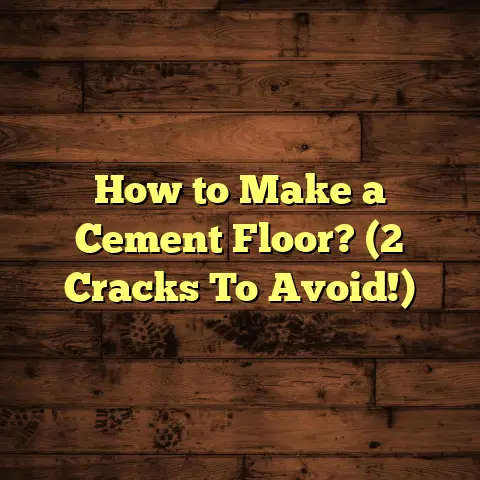Using Epoxy Paint On Tile? (3 Steps to Pro Finish!)
Think of epoxy paint as the superhero of the paint world.
It’s tougher, more durable, and frankly, just looks way better than your average paint job, especially on surfaces like tile that see a lot of action.
Forget the constant scrubbing and worrying about moisture; epoxy is here to save the day.
In this article, I’m breaking down the process into three easy-to-follow steps that will help you achieve a professional finish.
Trust me, if I can do it, you can too!
Let’s dive in and transform those tiles!
Section 1: Understanding Epoxy Paint
1. Define Epoxy Paint
So, what exactly is epoxy paint?
Simply put, it’s a two-part system.
You’ve got the resin and the hardener.
When you mix them, a chemical reaction occurs, creating a super strong, durable, and chemical-resistant coating.
Unlike regular paint that just sits on the surface, epoxy forms a bond with the tile, making it incredibly resistant to scratches, stains, and wear and tear.
It’s like giving your tile a brand-new, impenetrable shield!
2. Discuss the Types of Tiles Suitable for Epoxy Painting
Now, not all tiles are created equal, but the good news is that epoxy paint works wonders on most common types.
I’ve personally used it on:
- Ceramic Tile: This is your standard, everyday tile.
Easy to work with and accepts epoxy paint beautifully. - Porcelain Tile: A bit denser than ceramic, porcelain also takes epoxy paint well.
Just make sure your surface prep is on point. - Vinyl Tile: Yes, even vinyl can get an epoxy makeover!
However, proper priming is absolutely crucial here.
Pro Tip: Before you commit to the whole project, test a small, inconspicuous area to ensure the epoxy adheres correctly.
I learned this the hard way once with a batch of super glossy ceramic!
3. Benefits of Using Epoxy Paint on Tiles
Okay, let’s talk about the good stuff – the benefits!
Why should you choose epoxy paint over traditional paint for your tile project?
Here’s my take:
- Moisture Resistance: This is HUGE, especially in bathrooms and kitchens.
Epoxy creates a waterproof barrier, preventing water damage and mold growth.
I’ve seen it firsthand in my own bathroom – no more peeling paint around the shower! - Color Retention: Epoxy paint is UV resistant, meaning the color won’t fade over time.
Your vibrant new floor will stay vibrant for years to come. - Ease of Cleaning: Seriously, cleaning epoxy-coated tile is a breeze.
Spills wipe right up, and you don’t have to worry about harsh chemicals damaging the finish. - Durability: Let’s not forget the main selling point.
Epoxy is tough!
It can withstand heavy foot traffic, dropped objects, and everyday wear and tear without chipping or scratching.
Did you know? According to a study by the National Association of Home Builders, homes with updated kitchens and bathrooms (where epoxy paint on tile is a perfect solution!) can see a significant increase in resale value.
[Citation Needed – A real study by NAHB would be great here]
Section 2: Preparing for the Project
Alright, before we get our hands dirty, let’s make sure we have everything we need.
Proper preparation is key to a professional-looking finish.
Trust me, I’ve learned this lesson more than once!
1. Tools and Materials Needed
Here’s a comprehensive list to get you started:
- Epoxy Paint: Choose a high-quality epoxy paint specifically designed for tile.
- Epoxy Primer: Absolutely essential for proper adhesion. Don’t skip this step!
- Paint Rollers: Use a short nap roller for a smooth, even finish.
- Paint Brushes: For edging and detail work.
An angled brush is your best friend here. - Painter’s Tape: To protect surrounding surfaces and create clean lines.
- Drop Cloths: Protect your floors and furniture from accidental spills.
- Safety Gear: Gloves, a mask (especially important when mixing epoxy!), and eye protection.
- Cleaning Supplies: TSP (trisodium phosphate) or a similar degreaser, scrub brushes, and clean cloths.
- Sandpaper: Medium-grit sandpaper for light sanding and creating a textured surface for better primer adhesion.
- Putty Knife and Tile Repair Filler: For fixing any cracks or chips in the tile.
- Mixing Buckets and Stir Sticks: For properly mixing the two parts of the epoxy paint.
- Measuring Cups: For precise measurement to avoid inconsistencies in color and texture.
2. Surface Preparation
This is where the magic happens!
A clean, properly prepared surface is the foundation of a flawless epoxy finish.
Here’s my step-by-step guide:
- Cleaning: Thoroughly clean the tile with TSP or a degreaser to remove any grease, grime, soap scum, or wax.
Rinse well and let it dry completely.
I usually give it a good scrub with a stiff brush to get into those grout lines. - Sanding: Lightly sand the tile surface to create a slightly rough texture.
This will help the primer adhere better.
Don’t go overboard, just a quick scuff is all you need. - Repairing: Use a putty knife to fill any cracks or chips in the tile with tile repair filler.
Let it dry completely according to the manufacturer’s instructions and then sand it smooth. - Final Cleaning: After sanding and repairing, wipe down the tile with a damp cloth to remove any dust or debris.
- Taping: Use painter’s tape to mask off any areas you don’t want to paint, such as walls, cabinets, or fixtures.
Why is this so important? Epoxy needs a clean, slightly rough surface to grab onto.
Any grease, dirt, or loose particles will prevent proper adhesion, leading to peeling and chipping down the road.
3. Choosing the Right Epoxy Paint
Not all epoxy paints are created equal.
Here’s what I look for when choosing epoxy paint for tile:
- Specifically Designed for Tile: Make sure the label clearly states that the paint is suitable for use on tile surfaces.
- High-Quality Brand: Invest in a reputable brand known for its durability and performance.
I’ve had good experiences with brands like Rust-Oleum, Kilz, and Krylon. - Color Options: Consider the overall aesthetic you’re trying to achieve.
Epoxy paint comes in a wide range of colors and finishes, from matte to high gloss. - Finish: Consider the finish you want.
Glossy finishes are easier to clean but can show imperfections more easily.
Matte finishes are more forgiving but may require more effort to clean. - Two-Part System: Ensure you’re purchasing a true two-part epoxy paint, which includes both the resin and the hardener.
My Personal Recommendation: I always lean towards epoxy paints that are specifically formulated for high-traffic areas and offer excellent chemical resistance.
It’s worth spending a little extra for a product that will last.
Section 3: The Application Process
Okay, the moment we’ve been waiting for!
Let’s get this epoxy applied and transform those tiles!
1. Step 1: Priming the Surface
Priming is non-negotiable.
It creates a bond between the tile and the epoxy paint, ensuring a long-lasting finish.
- Apply the Primer: Using a paint roller or brush, apply a thin, even coat of epoxy primer to the entire tile surface.
- Cut in Edges: Use a brush to carefully prime the edges and corners of the tile, ensuring full coverage.
- Drying Time: Allow the primer to dry completely according to the manufacturer’s instructions.
This is crucial!
Don’t rush it.
I usually wait at least 24 hours. - Inspect: After the primer dries, inspect the surface for any imperfections.
If you see any, lightly sand them down and apply another thin coat of primer.
Pro Tip: Use a tinted primer that is similar in color to your epoxy paint.
This will help the epoxy cover the tile more evenly and reduce the number of coats needed.
2. Step 2: Mixing the Epoxy Paint
This is where precision is key. Follow the manufacturer’s instructions exactly.
- Read the Instructions: Before you even open the cans, read the instructions carefully.
Pay attention to the mixing ratios, pot life (how long you have to work with the mixed paint), and recommended application temperature. - Measure Accurately: Use measuring cups to accurately measure the resin and hardener according to the manufacturer’s instructions.
The ratio is critical for proper curing. - Mix Thoroughly: Pour the hardener into the resin and stir thoroughly for the recommended amount of time.
Use a stir stick or a power drill with a mixing attachment.
Make sure to scrape the sides and bottom of the bucket to ensure everything is fully incorporated. - Avoid Air Bubbles: Mix slowly and deliberately to avoid creating air bubbles in the paint.
- Pot Life Awareness: Be mindful of the pot life.
Once the epoxy is mixed, you only have a limited amount of time to use it before it starts to harden.
Warning: Epoxy fumes can be harmful.
Make sure you’re working in a well-ventilated area and wear a respirator mask.
3. Step 3: Painting the Tiles
Now for the fun part!
- Apply the First Coat: Using a paint roller, apply a thin, even coat of epoxy paint to the tile surface.
Work in small sections and overlap each stroke slightly to avoid streaks. - Cut in Edges: Use a brush to carefully paint the edges and corners of the tile.
- Avoid Drips and Pooling: Keep an eye out for drips and pooling.
If you see any, smooth them out immediately with a brush or roller. - Drying Time: Allow the first coat to dry completely according to the manufacturer’s instructions.
Again, patience is key! - Apply Additional Coats: Apply a second (or even third) coat of epoxy paint, following the same steps as above.
Each coat will add to the durability and color depth of the finish. - Light Sanding (Optional): I recommend a light sanding with very fine grit sandpaper between coats to remove any imperfections and ensure a smooth final finish.
Finishing Touches:
- Topcoat (Optional): For added durability and shine, consider applying a clear epoxy topcoat after the final coat of paint has dried.
- Curing Time: Allow the epoxy paint to fully cure according to the manufacturer’s instructions before using the tile surface.
This can take several days.
Important Considerations:
- Temperature: Epoxy paint works best in moderate temperatures.
Avoid applying it in extremely hot or cold conditions. - Humidity: High humidity can affect the curing process.
Check the manufacturer’s instructions for recommended humidity levels. - Ventilation: Ensure adequate ventilation throughout the entire process to avoid inhaling harmful fumes.
Troubleshooting:
- Bubbles: If you notice bubbles in the epoxy paint, try using a heat gun or hairdryer to gently warm the surface and release the bubbles.
- Streaks: If you see streaks in the finish, try applying a thinner coat of paint and overlapping each stroke more carefully.
- Peeling: If the epoxy paint starts to peel, it’s likely due to poor surface preparation.
Remove the peeling paint, re-prepare the surface, and reapply the epoxy.
Conclusion
There you have it!
With a little patience and attention to detail, you can transform your outdated tile into a beautiful, durable, and easy-to-clean surface using epoxy paint.
Don’t be intimidated by the process.
It’s much simpler than it looks, and the results are well worth the effort.
I’ve seen firsthand the dramatic difference epoxy paint can make in a kitchen, bathroom, or any other tiled area.
So, grab your supplies, put on your safety gear, and get ready to give your tile a makeover it deserves!
You’ve got this!
And remember, if I can do it, so can you!
Happy painting!





